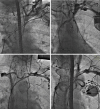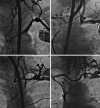Pacemaker leads as a potential source of problems in patients who might need a central venous access port
- PMID: 38162103
- PMCID: PMC10753236
- DOI: 10.21037/cdt-23-104
Pacemaker leads as a potential source of problems in patients who might need a central venous access port
Abstract
Background: Lead-dependent venous occlusion may impede the insertion of a central venous access device (CVAD). The aim of this retrospective, cohort study was to assess the chance of implantation of CVAD in patients with cardiac implantable electronic devices (CIEDs).
Methods: We reviewed and analyzed 3,075 venograms of patients with CIEDs undergoing transvenous lead extraction (TLE) between June 2008 and July 2021. Relationship between venous patency and the chance of CVAD placement was estimated.
Results: In 2,318 (75.38%) patients, venography showed no potential obstacles to venous port implantation on the ipsilateral side. In patients with leads on the left side, significant narrowing more often affected the subclavian vein than the brachiocephalic vein [1,595 (55.29%) vs. 830 (28.63%), respectively] or the superior vena cava (SVC) [21 (0.73%) cases]. Furthermore, the subclavian and brachiocephalic veins on the opposite side were also narrowed [35 (2.35%) and 27 (1.24%), respectively]. The chances of port insertion were assessed as easy on CIED side or opposite side in 2,318 (75.38%) and 2,291 (97.91%) patients, respectively), as difficult insertion/questionable performance in 246 (8.00%) and 22 (0.94% patients) and doubtful or impossible insertion/questionable performance in 511 (16.62%)/27 (1.15%) patients with CIED.
Conclusions: (I) Varying degrees of lead-dependent venous obstruction (LDVO) is a frequent finding in patients with CIEDs; (II) the major thoracic veins on the opposite side of the chest may also be significantly narrowed; (III) venography should be considered before attempted CVAD insertion in patients with long lead dwell times or in patients after CIED removal, including planned contralateral port placement.
Keywords: Endocardial leads; lead-related venous obstruction; venography; venous port complications; venous port implantation.
2023 Cardiovascular Diagnosis and Therapy. All rights reserved.
Conflict of interest statement
Conflicts of Interest: All authors have completed the ICMJE uniform disclosure form (available at https://cdt.amegroups.com/article/view/10.21037/cdt-23-104/coif). The authors have no conflicts of interest to declare.
Figures



Similar articles
-
Severity and Extent of Lead-Related Venous Obstruction in More Than 3000 Patients Undergoing Transvenous Lead Extraction.Vasc Health Risk Manag. 2022 Aug 17;18:629-642. doi: 10.2147/VHRM.S369342. eCollection 2022. Vasc Health Risk Manag. 2022. PMID: 36003848 Free PMC article.
-
Incidence of central vein stenosis and occlusion following upper extremity PICC and port placement.Cardiovasc Intervent Radiol. 2003 Mar-Apr;26(2):123-7. doi: 10.1007/s00270-002-2628-z. Epub 2003 Mar 6. Cardiovasc Intervent Radiol. 2003. PMID: 12616419
-
Double superior vena cava and left brachiocephalic vein agenesis: a rare systemic vein anomaly and potential source of cardiac implantable electronic device and central venous catheter placement complications.Folia Morphol (Warsz). 2022;81(4):1066-1071. doi: 10.5603/FM.a2021.0108. Epub 2021 Oct 26. Folia Morphol (Warsz). 2022. PMID: 34699053
-
Superior vena cava obstruction and cardiovascular implantable electronic devices-a new era of leadless devices.Mediastinum. 2023 Dec 12;8:1. doi: 10.21037/med-23-33. eCollection 2024. Mediastinum. 2023. PMID: 38322191 Free PMC article. Review.
-
How to perform extrathoracic venous access for cardiac implantable electronic device placement: Detailed description of techniques.Heart Rhythm. 2022 Jul;19(7):1184-1191. doi: 10.1016/j.hrthm.2022.02.020. Epub 2022 Feb 26. Heart Rhythm. 2022. PMID: 35231611 Review.
References
LinkOut - more resources
Full Text Sources
